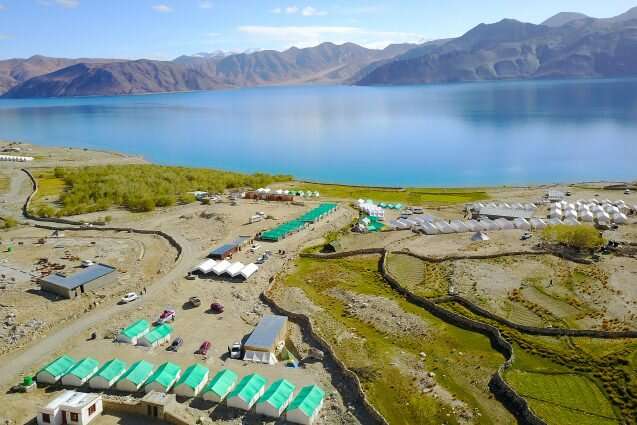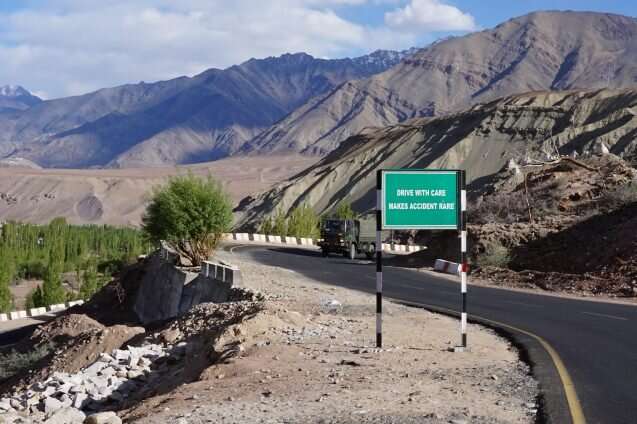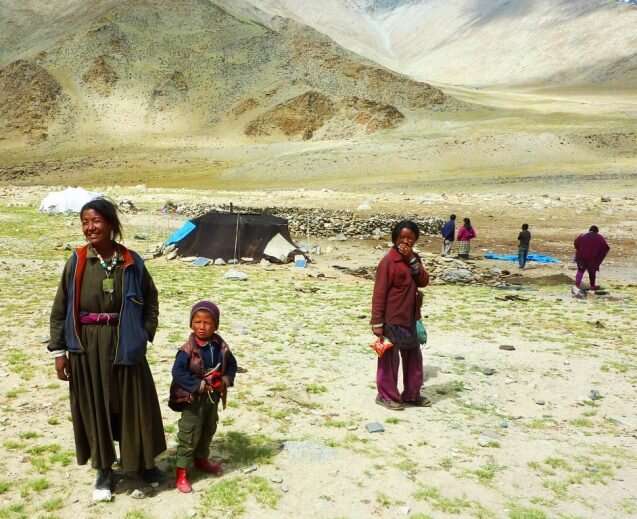Tourist camps on the Indian shore of Pangong Tso. Credit: Eatcha via Wikimedia Commons
International attention returned to the ill-defined Himalayan border between India and China last month as disputes between soldiers stationed there escalated into beatings and fistfights. In recent days, both countries have been working to diplomatically resolve the tension, which has been ongoing with occasional episodes of heightened hostility since a border was first drawn decades ago. This latest geopolitical spat is just one chapter of a long history of statemaking projects that have had environmental and social consequences on local peoples.
Skirmishes broke out in May along the Line of Actual Control (LAC), a disputed demarcation line along the China-India border. The line was established as the boundary between the two nations following the 1962 Sino-Indian War, which lasted a month and claimed the lives of 722 Chinese soldiers and 1,383 Indian soldiers. The countries signed a bilateral peace agreement in 1993, officially adopting the LAC. This still-disputed border separates Indian-controlled territory from Chinese-controlled territory. In the western section, where recent conflicts took place, it traverses the Chinese-controlled Aksai Chin, Tibet Autonomous Region in China, and Ladakh, an Indian union territory.
The standoffs in May took place in the Galwan Valley and near Pangong Tso, a glacial lake stretching from Ladakh into Tibet, and involved Indian and Chinese soldiers fist-fighting and beating each other with rocks and clubs, according to the New York Times. No shots were fired, in accordance with the nations' peace agreement. While the tensions are decades in the making, this latest incident gathered attention because both governments reacted to the altercations by sending in thousands more troops to the region. A similar level of conflict has not occurred since 2017, when the two countries engaged in a standoff near the eastern part of their border.
According to Indian officials, Chinese soldiers encroached on Indian-controlled territory, which may have been motivated by India's latest efforts to build military roads winding through the mountains. The area is important to both countries due to its proximity to sensitive regions with large minority populations: Kashmir for India, and Tibet and Xinjiang for China. Tensions between the two governments are further fueled by political factors, including China's growing alliance with Pakistan, which is especially relevant considering Pakistan and India's current disputes over Jammu and Kashmir, an ongoing hotspot since the partition of India after independence from Britain in 1947. Further, India has refused to participate in China's ambitious global infrastructure project, the Belt and Road Initiative, a centerpiece of Beijing's foreign policy.
However, foreign affairs and defense ministry officials from both China and India affirmed early on that the situation was stable, and diplomatic negotiations were underway. Despite recent small-scale conflicts and ongoing tensions, most analysts do not expect the countries to go to war.
A road sign near Basgo, Ladakh, India. Credit: Bernard Gagnon via Wikimedia Commons
"No factor has been more important in keeping the peace between India and China than the Himalayas," Thomas J. Christensen, director of the China and the World program at Columbia University, told GlacierHub. He said that the harsh climate of the highest peaks in the world disincentivizes both nations from escalating conflict and going on the offensive.
Indeed, the remote regions of the Himalayas are challenging for militaries and dangerous for soldiers. The border is high in the mountains and difficult to access. The armies who regularly patrol the border must acclimate to the high altitude and harsh climate. The extreme changes in weather that mountain regions are prone to, such as heavy snows that block mountain passes, can make military operations difficult. In addition, soldiers have been harmed by landslides and related disasters that plague the mountains and surrounding valleys.
At the same time, increasing militarization and infrastructure development in the region has serious consequences for the environment. Ruth Gamble, a historian at La Trobe University in Australia, spoke with GlacierHub about how environmental harm is often overlooked in the conversation about China-India border disputes. "You're dealing with two countries that are both nuclear-armed [and] have unresolved border tensions," Gamble said, acknowledging why international attention is often dedicated to geopolitics. "[But their activities are] slowly wearing away at communities and environments."
The Himalayas are a critical ecological region—they serve as the source of water for millions of people in Asia, sustain fertile valleys in the subcontinent, and are famously biodiverse. But climate change is already impacting the region at alarming rates, and military operations are contributing to the problem. The pollution from military vehicles, disturbances from infrastructure development, stress caused from increased human presence and activity, and even improper disposal of human waste all impact the fragile ecosystems of the remotest parts of the Himalayas. These areas, long inhabited and visited by indigenous communities, have received a growing presence of non-indigenous populations since borders were drawn and armies arrived.
Pollution is one of the many environmental consequences of military operations. "Heightened levels of air pollution will have significant health implications for the local population, as well as stationed military officers," Jessica Field, a humanitarian studies expert at University College London and the Jindal School of International Affairs, told GlacierHub. Air pollutants also contribute to long-term warming and heighten the likelihood of landslides, flash floods, and other disasters that already endanger soldiers and civilians in the region.
Changpa people in Changtang, Ladakh. Credit: John Hill via Wikimedia Commons
Sovereignty disputes also have complicated impacts on local communities, who historically have had a significant degree of autonomy from the central governments of India and China. When India, China, and Britain first drew maps to divide the Himalayas, they did not take into account historical connections between lands and peoples. As military activity and infrastructure development increases, the growing influence of India and China can threaten the cultural and linguistic diversity emblematic of the region. Communities in regions near the LAC practice Buddhism, Hinduism, Islam, and local religious traditions, and they speak a multitude of languages, including many that are endangered. In Leh, the capital of Ladakh, residents speak the Tibetic language Ladakhi. Most practice Buddhism, but there are a significant minority of Muslims and Hindus as well.
Karine Gagné, an anthropologist at the University of Guelph, talked to GlacierHub about the long history of indigenous peoples in this region and their close connection with the landscape. She described how communities are impacted by the presence of troops, both Indian and Chinese. For example, military operations can interrupt the livelihoods of nomadic communities by disturbing the grazing cycles of their livestock. Pastoralist Changpa communities graze their goats, yaks, and other animals in seasonal pastures on the Changtang plateau, which stretches from Tibet to Ladakh. Herders on the Indian side of the border say that recent land-grabbing by China contributed to the deaths of many young pashmina goats. Disputes along the border cut off access to pastures and lands necessary to raise these animals, which can eventually cause local residents to abandon their traditional ways of life and look for work in towns and cities.
But the militaries are not always complete outsiders: according to Gamble, in Ladakh, some residents have built trust with the Indian soldiers in their areas. The Indian Army employs and does business with locals, and their presence helps facilitate tourism, an economic activity of growing importance in the region.
Despite the complex context, environmental experts agree that steps must be taken to preserve the ecosystems around the LAC. According to Gamble, proposed solutions include reforms that are already being implemented, such as exhaust filters for military trucks and decreased reliance on kerosene and diesel fuel. Field emphasized the importance of central governments collaborating with local peoples and groups to use the ecological knowledge they have gained over years of familiarity with the region. Longer-term actions that would require international cooperation could also be considered, like demilitarizing and de-escalating tensions, or designating national or international park status to more parts of the region.
The degradation of ecosystems and stress on indigenous peoples should not be accepted as the collateral damage of sovereignty disputes between global superpowers. The Himalayas are ecologically and culturally critical, and it is imperative that China and India work toward long-term solutions to preserve the areas along their borders. Himalayan communities are already feeling the impacts of climate change, and mitigating such harms will require more than just peaceful foreign relations.
"Even in times of peace," said Field, "long trails of [military] trucks can be seen moving goods and troops across the region daily, spewing black exhaust fumes into the air… [Environmental] impacts will not dissipate when the 'standoff' is resolved."
Provided by Earth Institute at Columbia University
This story is republished courtesy of Earth Institute, Columbia University http://blogs.ei.columbia.edu.























